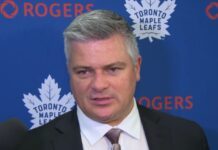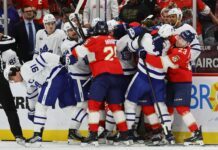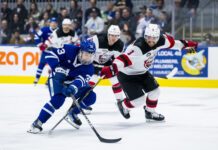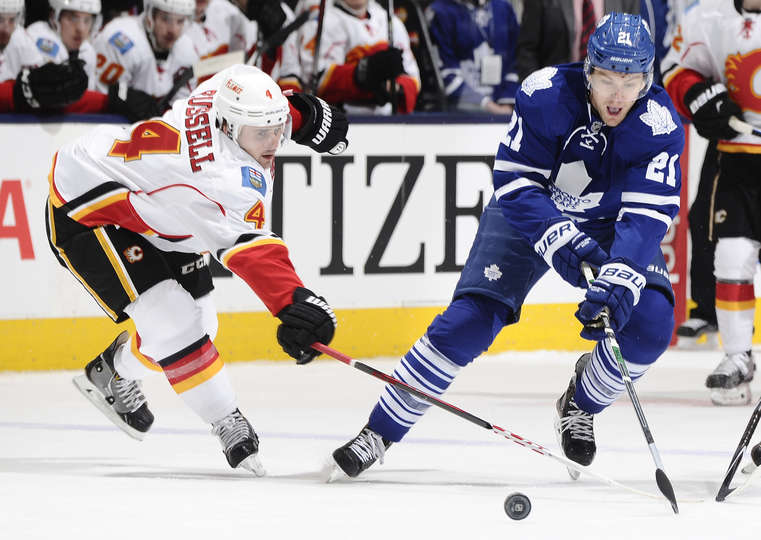I didn’t have any particular topic I wanted to write about this week, so yesterday morning I asked my twitter followers what they wanted me to write about as far as a statistical analysis of the Leafs is concerned.
I’ll tackle a few of those questions today.
James van Riemsdyk
I had a question from @breakaway23 on James van Riemsdyk’s career season pace thus far, which has been mostly overlooked. If we project JVR’s stats to the 80 games he played last season, we have the following prorated stats:
| GP | G | A | Pts | |
|---|---|---|---|---|
| 2012-13 | 80 | 30 | 23 | 53 |
| 2013-14 | 80 | 30 | 31 | 61 |
| 2014-15 | 80 | 35 | 37 | 72 |
JVR’s goal rate has remained very steady the past three seasons, while his assist rate has steadily improved. It is possible that JVR is becoming a better passer as he gains experience playing in the NHL (he is still only 25), but it is also likely that the boost in assist rate is tied to Bozak’s improved goal production. Maybe the two go hand-in-hand, but as I have mentioned previously, I am not certain Bozak’s stats are sustainable and that would impact JVR’s assist rate. I still see JVR as more of a goal scorer than a playmaker, so for him I think the goal rates are key and those are pretty steady (and pretty good).
Sustainability of PDO
I had a question from @CheepnisNHL regarding the lack of regression of the Leafs PDO over the past few seasons. Let’s first look at the Leafs 5v5 PDO over the past 3 seasons to see what it has been like.
| Sh% | Sv% | PDO | ||
|---|---|---|---|---|
| 2012-13 | 10.57 | 92.4 | 103 | |
| 2013-14 | 8.42 | 92.8 | 101.3 | |
| 2014-15 | 9.41 | 92.5 | 101.9 |
I think a significant portion of the the variability in shooting percentage has been the roster changes up front, plus injuries. It is pretty clear that individual players do have an ability to sustain elevated on-ice shooting percentages and the Leafs have had an abundance of those players.
Lupul, Kessel, JVR, Bozak and Kadri all seem to be those kind of players as all have had very good on-ice shooting percentages the past several seasons (including when they were on other teams for Lupul, Kessel and JVR). In the past the Leafs have also had Grabovski, MacArthur and Kulemin on the team, all of whom seem to be high on-ice shooting percentage players as well. The 2012-13 season, which had all of these guys on it, they were likely legitimately a really high shooting percentage team (maybe not 10.57%, but abnormally high and likely well over a 9% shooting team).
The Leafs save percentage has been far more stable than their shooting percentage. I think their save percentage is perfectly reasonable. It is a little above average, but not extreme to the point where regression is obvious. They also give up a lot of shots, which I have suggested can lead to a boost in save percentage (the extra shots are not necessarily more difficult).
Prior to this season, I expressed doubts that the Leafs could sustain a significantly higher than normal team shooting percentage because a number of the guys they picked up (Santorelli, Winnik, Booth, Clarkson, Komarov) were traditionally low-shooting percentage players. Many of these guys currently have high on-ice shooting percentages that suggest they aren’t unsustainable. Komarov won’t finish the season at 12.88%. Santorelli won’t finish the season at 12.72%, nor will Lupul at 12.50%. No player, not even Sidney Crosby, has finished a season that high. In the case of Santorelli and Komarov, a more typical season for them is likely around 7%. David Clarkson’s on-ice shooting percentage is 9.94%, while his average over the past four seasons is a meagre 5.71%.
That said, the Leafs top line of Kessel-Bozak-JVR has been below normal this season in 5v5 on-ice shooting percentage; so, as some of those guys above drop, the top trio should improve. That said, it is probably safe to expect the Leafs overall shooting percentage, and thus PDO, to drop some over the remainder of the season, but they are likely to remain an above average PDO team because they are probably legitimately an above-average team in both shooting and save percentages.
The Defense
I had a number of questions about the Leafs defense. I’ll give a few thoughts here, but I’ll maybe look into them in greater detail next week.
@BigFourInsider asked about Cody Franson, how awesome he is, and how the Leafs need to pay him now. A number of articles have been written about this recently and everyone seems to have an opinion on Franson. The reality is he is good. Very good. Over the past 5 seasons he ranks 8th among defensemen in points per 60 minutes of ice time, trailing only Karlsson, Letang, Keith, Byfuglien (who has played a lot at forward), Hedman, Yandle and Green. This season he sits sixth. In terms of IPP (individual points percentage, an indication of how involved he is in the offense), he ranks 7th among defensemen over the past 5 seasons. The guy is a high end offensive defenseman. He is also likely at least an average defensive defenseman. If Franson left as a UFA at the end of the season, it would be a big loss to the Leafs.
@Spillandy wanted me to discuss Jake Gardiner’s possession numbers. Let’s have a look at Gardiner’s possession numbers over the past few seasons.
| Season | CF60 | CA60 | CF% | CF% RelTM |
|---|---|---|---|---|
| 2011-12 | 59.43 | 59.57 | 49.9 | 1.7 |
| 2012-13 | 54.54 | 59.66 | 47.8 | 4.1 |
| 2013-14 | 52.59 | 60.6 | 46.5 | 5.2 |
| 2014-15 | 46.51 | 58.41 | 44.3 | -1.9 |
Gardiner’s CF% has slowly been falling, but that is largely due to the overall fall of the team in terms of possession. For CF% RelTM, which is an indication of Gardiner’s impact on his teammates, until this season it was steadily improving. So far this season, though, Gardiner has struggled. Let’s look at how Gardiner has performed with his various defense partners.
| CF60 | CA60 | CF% | |
|---|---|---|---|
| Robidas | 38.31 | 47.19 | 44.8 |
| Polak | 45.15 | 60.18 | 42.9 |
| Holzer | 37.68 | 67.83 | 35.7 |
| Rielly | 61.86 | 59.82 | 50.8 |
When partnered with Robidas, the duo did a good job at limiting chances against but struggled offensively. With Polak, the pair struggled both offensively and defensively. With Holzer, the two were absolutely terrible offensively and defensively, giving up nearly twice as many shots as they generated. With Rielly, the offense was very good but they weren’t great at limiting shots against (it’s a problem for the whole team, though). The Gardiner-Rielly pairing had a 54.6 CF% last season, generating a lot of offense. Gardiner also played fairly well with Franson last season. It is difficult to really pinpoint exactly why Gardiner is struggling this season, but I think it would help if he was given a regular defense partner to work with (maybe ideally Robidas or Rielly, depending on how you choose to use him).
Finally, I had a question from @PlatosStudent about Robidas and his future of the team when Polak gets back, as well as Holzer’s possession numbers. I think Robidas’ future with the team is on pretty firm ground right now. They have a 3-year commitment to him and I don’t see that changing any time soon. When Polak returns, Holzer is probably the odd man out. Holzer’s possession numbers and corsi against numbers are terribly bad and he has little to no offensive ability, so if he isn’t preventing chances against he isn’t very useful.


































